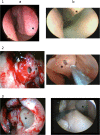A feasible, low-cost, reproducible lamb's head model for endoscopic sinus surgery training
- PMID: 28662196
- PMCID: PMC5491169
- DOI: 10.1371/journal.pone.0180273
A feasible, low-cost, reproducible lamb's head model for endoscopic sinus surgery training
Abstract
Objective: To describe and standardize a reproducible, viable, low-cost lamb's head model for endoscopic sinus surgery training.
Methods: Otorhinolaryngology residents performed the following three endoscopic sinus surgeries using the lamb's head model: inferior turbinectomy, bullectomy, and maxillary antrostomy. Each student dissected 10 specimens before training these procedures on human patients, and the benefit of the animal model training was evaluated.
Results: Nineteen resident physicians of comparable academic level participated in training. All participants agreed that the lamb's head model dissections improved their skills in using surgical and videoendoscopic instruments, 90% agreed that the dissections improved their confidence with respect to training in human patients, and all stated they would recommend the same training to future residents.
Discussion: Lamb's heads have been used for training in endoscopic sinus surgery. However, no standardization of this training had been performed to ensure that it is a valuable tool for learning and skill-building. The standardized method described in this study increased resident physicians' skills and confidence before beginning their training on human patients. Moreover, our results demonstrate the feasibility of the model, considering its low cost and reproducibility.
Conclusion: Future studies with this model should be conducted to assess whether the resulting increase in skills prevents and reduces medical errors, increases patient safety, reduces surgical costs, and improves the quality of otorhinolaryngological care.
Conflict of interest statement
Figures
References
-
- Kinsella JB, Calhoun KH, Bradfield JJ, Hokanson JA, Bailey BJ. Complications of Endoscopic Sinus Surgery in a Residency Training Program. Laryngoscope. 1995;105(10):1029–32. doi: 10.1288/00005537-199504000-00007 - DOI - PubMed
-
- Hosemann W, Draf C. Danger Points, Complications and Medico-Legal Aspects in Endoscopic Sinus Surgery. GMS Curr Top Otorhinolaryngol Head Neck Surg. 2013;12:Doc06 doi: 10.3205/cto000098 - DOI - PMC - PubMed
-
- World Health Organization (WHO). WHO Patient Safety Curriculum Guide for Medical Schools [Internet]. World Health Organization (WHO) 2009. Available from: http://apps.who.int/iris/bitstream/10665/44091/1/9789241598316_eng.pdf.
-
- Zuckerman JD, Wise SK, Rogers GA, Senior BA, Schlosser RJ, DelGaudio JM. The Utility of Cadaver Dissection in Endoscopic Sinus Surgery Training Courses. Am J Rhinol Allergy. 2009;23(2):218–24. doi: 10.2500/ajra.2009.23.3297 - DOI - PubMed
-
- Briner HR, Simmen D, Jones N, Manestar D, Manestar M, Lang A, et al. Evaluation of an Anatomic Model of the Paranasal Sinuses for Endonasal Surgical Training. Rhinology. 2007;45(1):20–3. - PubMed
MeSH terms
LinkOut - more resources
Full Text Sources
Other Literature Sources
Medical
Molecular Biology Databases



